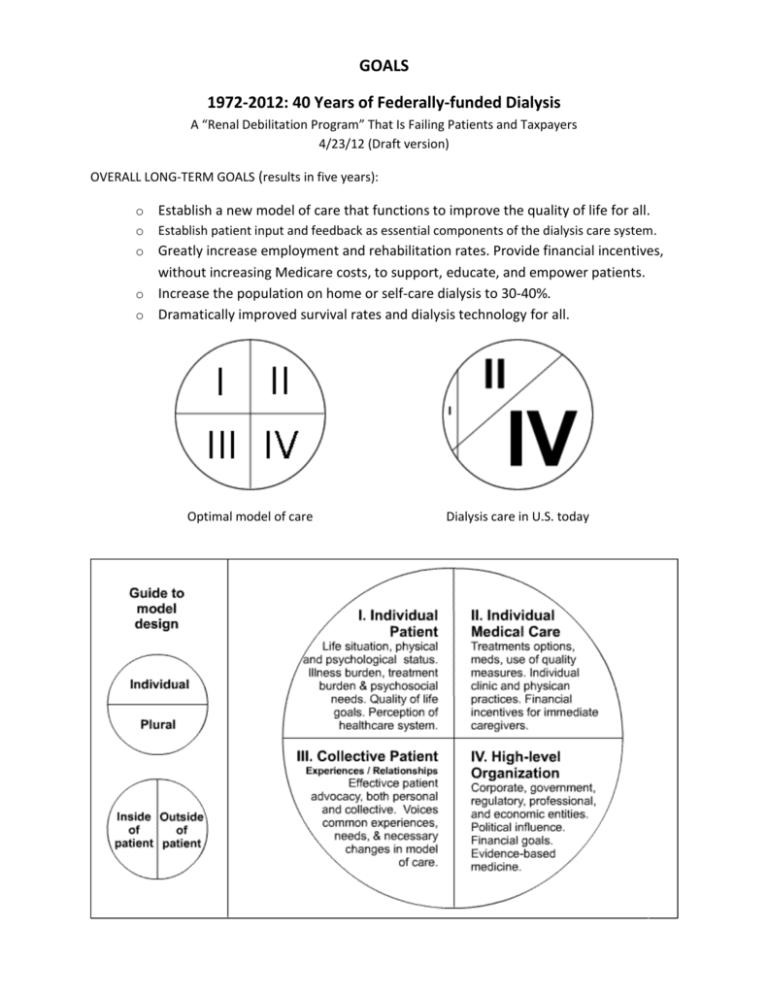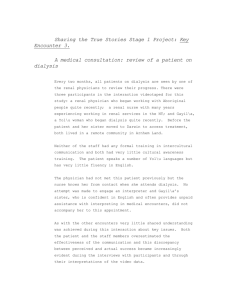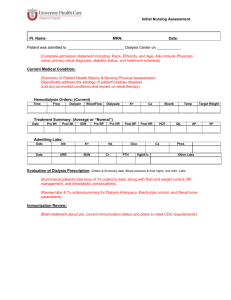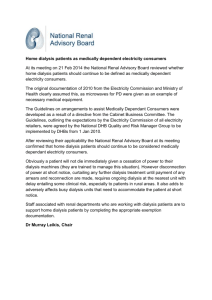GOALS 1972-2012: 40 Years of Federally-funded
advertisement

GOALS 1972-2012: 40 Years of Federally-funded Dialysis A “Renal Debilitation Program” That Is Failing Patients and Taxpayers 4/23/12 (Draft version) OVERALL LONG-TERM GOALS (results in five years): o o o Establish a new model of care that functions to improve the quality of life for all. Establish patient input and feedback as essential components of the dialysis care system. Greatly increase employment and rehabilitation rates. Provide financial incentives, without increasing Medicare costs, to support, educate, and empower patients. o Increase the population on home or self-care dialysis to 30-40%. o Dramatically improved survival rates and dialysis technology for all. Optimal model of care Dialysis care in U.S. today SHORT-TERM GOALS: 1. Educate Congress, patients, and the public about the dysfunctional system in dialysis care, its failure to meet the program’s original intention of patient employment and rehabilitation, its failure to significantly improve outcomes important for patients, and the patients’ low quality of life. 2. Define the problem as systemic, requiring new roles/ duties for all involved parties (providers, CMS, nephrologists, renal organizations, renal professionals, patient groups, Congress). 3. Increase awareness and importance of the medical, economic, and societal benefits greatly reducing dialysis patient disability and debilitation. Establish how better outcomes for both dialysis patients and taxpayers can be achieved by increasing patient employment and re/habilitation. 4. Starting with employed patients, create and establish a well-patient model of for renal replacement therapy that will drive improvements in all patients’ health-related quality of life, dialysis technology, and the system of care. Five years from now, make it the norm and expectation for any employed patient who enters this system of care to remain employed. 5. Request congressional hearings as soon as possible to set a new, corrective direction for the entire system of dialysis care. Expose the dysfunctional system, the parties involved, and the system’s problems o Begin by asking all involved parties why the original intent of the federal program, patient employment and re/habilitation, has been ignored. o Reveal that virtually no dialysis patient employment or rehabilitation programs exist o Ask why patient-specific employment data isn’t tracked over time and published in any of these databases: USRDS, DOPPS, CMS, Forum of ESRD Networks? o Ask the leaders of this medical/industrial complex what therapy they would choose for themselves o Ask if CMS’s quality improvement programs are playing a role in improving patients’ health-related quality of life o Hear testimony from the most frustrated patients and medical professionals, as well as the most successful patients. Have patients and professionals testify on the benefits of employment and re/habilitation. Instead of calling for more medical studies, urge Congress to embrace a “common sense” and utilitarian solution based on patient employment and re/habilitation Have Congress recognize the necessity of changing the activities and direction of all involved parties in the system of care As a starting point, have Congress insist on a 5-year coordinated push by all involved parties to increase patient employment. Possible actions: o Extend the Medicare Secondary Payer (MSP) period when patients are kept employed. (This will REDUCE Medicare costs.) o Provide tax breaks/credits to companies that employ dialysis patients and provide health insurance o o o Dialysis patients and others collecting disability insurance income based upon being 100% disabled should be able to attempt to return to the workforce without the fear of losing their disability insurance income if their employment gets interrupted due to their disability. Provide incentives for dialysis facilities to offer treatment shifts starting after 5 pm. Require large dialysis providers to hire some dialysis patients in appropriate positions. Have CMS begin measuring and publishing dialysis patient employment on Dialysis Facility Compare and in the dialysis facilities. Identify and publically acknowledge which facilities keep patients healthy and working over extended periods of time. Congress should develop a bigger economic picture of renal replacement therapy. Establish all societal costs of failing to target employment and rehabilitation as part of major organ replacement therapy, including disability payments, food stamps, transportation, social services provided to families, as well as lost tax revenues and lost opportunity costs. Request a GAO study on the Economic Benefits of Renal Rehabilitation. Congress should realign as many corporate financial incentives as possible to deliver positive outcomes for taxpayers and patients and improve patient survival. Congress should have regular reviews of industry practices by outsiders (industry is too in-bred). 6. Be careful not to suggest excluding anyone from receiving dialysis treatments, but educate on the appropriateness of renal replacement therapy(for patient/family/physician decisions). MUST DO’s FOR FUTURE: ACOs and medical homes must be focused on patient employment and rehabilitation. Develop collective patient voice; accumulate patient experiences. Consider psychosocial issues as important as medical issues for long-term patient survival. Use new markers for OVERALL quality dialysis care. As a start, use an easily definable and understood parameter: patient employment. Over time, develop markers for all age groups and comorbidities. Consider a new medical specialty/specialist that provides a comprehensive approach to renal replacement therapy. It will specialize in a body of medical knowledge, coordinating multifaceted care with each patient’s priorities, keeping patients at their highest level of functioning, minimizing overall economic costs, and developing tools for effective patient education and motivation. NOTES ON SHORT-TERM SOLUTIONS Focus first on patient employment. Insist on a 5-year focus and thrust on increasing patient employment. Congress must recognize that the financial incentives that CMS has created to improve the quality of dialysis care are ineffective. They have little impact on patients’ lives or improving employment. Congress must create new financial incentives to increase employment, technology development, and a diversity of approaches without establishing more unintended consequences that limit access to care for those disabled with other conditions and unemployed needing rehabilitation services to become employed. The most powerful tool that Congress has to correct the system of care is to provide temporary, high-margin, financial incentives for the largest corporations to increase patient employment. The most obvious is to extend the Medicare Secondary Payer (MSP) period when patients are kept employed. This will REDUCE Medicare costs. Additionally, companies that employ dialysis patients and provide health insurance will require tax breaks/credits. The cost of tax breaks and/or credits should be outweighed by the accrued benefits of higher tax revenue, lower Medicare costs, disability insurance, food stamps, etc. Need to be careful about unintended consequences. The Social Security Administration looks at people who can go back to work as not 100% disabled. If the person loses the job we need to make sure they are seen as 100% disabled immediately upon the interruption of employment. Congress must set a coordinated, national-level agenda that will demand a collective effort from CMS, Congress, providers, nephrologists, renal organizations, and patient groups. With so many “players” and diverse agendas, only Congress can set a unifying target for all that will effectively improve the system of care. Redefine the purpose of end-stage renal disease (ESRD) program from a one that simply provides a live-saving therapy to one that focuses on patient employment and rehabilitation. Begin by changing its name (suggestion: Renal Rehabilitation Program). Hold congressional hearings regularly to hold all parties accountable for making progress.





